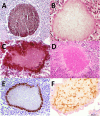An updated list of eumycetoma causative agents and their differences in grain formation and treatment response
- PMID: 38690871
- PMCID: PMC11237709
- DOI: 10.1128/cmr.00034-23
An updated list of eumycetoma causative agents and their differences in grain formation and treatment response
Abstract
SUMMARYIn 2023, the World Health Organization designated eumycetoma causative agents as high-priority pathogens on its list of fungal priority pathogens. Despite this recognition, a comprehensive understanding of these causative agents is lacking, and potential variations in clinical manifestations or therapeutic responses remain unclear. In this review, 12,379 eumycetoma cases were reviewed. In total, 69 different fungal species were identified as causative agents. However, some were only identified once, and there was no supporting evidence that they were indeed present in the grain. Madurella mycetomatis was by far the most commonly reported fungal causative agent. In most studies, identification of the fungus at the species level was based on culture or histology, which was prone to misidentifications. The newly used molecular identification tools identified new causative agents. Clinically, no differences were reported in the appearance of the lesion, but variations in mycetoma grain formation and antifungal susceptibility were observed. Although attempts were made to explore the differences in clinical outcomes based on antifungal susceptibility, the lack of large clinical trials and the inclusion of surgery as standard treatment posed challenges in drawing definitive conclusions. Limited case series suggested that eumycetoma cases caused by Fusarium species were less responsive to treatment than those caused by Madurella mycetomatis. However, further research is imperative for a comprehensive understanding.
Keywords: biofilm; diagnosis; grain; itraconazole; molecular diagnostics; mycetoma; neglected tropical disease; susceptibility.
Conflict of interest statement
The authors declare no conflict of interest.
Figures






Similar articles
-
Ibrexafungerp prolongs survival and reduces the eumycetoma grain size in Galleria mellonella infection models of two different causative agents of eumycetoma.J Antimicrob Chemother. 2025 Jun 3;80(6):1733-1741. doi: 10.1093/jac/dkaf133. J Antimicrob Chemother. 2025. PMID: 40304084 Free PMC article.
-
Eumycetoma causative agents are inhibited in vitro by luliconazole, lanoconazole and ravuconazole.Mycoses. 2022 Jun;65(6):650-655. doi: 10.1111/myc.13442. Epub 2022 May 6. Mycoses. 2022. PMID: 35398930 Free PMC article.
-
Novel Compound MMV1804559 from the Global Health Priority Box Exhibits In Vitro and In Vivo Activity against Madurella mycetomatis.Int J Mol Sci. 2024 Jun 5;25(11):6227. doi: 10.3390/ijms25116227. Int J Mol Sci. 2024. PMID: 38892422 Free PMC article.
-
Mycetoma caused by Madurella mycetomatis: a neglected infectious burden.Lancet Infect Dis. 2004 Sep;4(9):566-74. doi: 10.1016/S1473-3099(04)01131-4. Lancet Infect Dis. 2004. PMID: 15336224 Review.
-
Madurella mycetomatis causing eumycetoma medical treatment: The challenges and prospects.PLoS Negl Trop Dis. 2020 Aug 27;14(8):e0008307. doi: 10.1371/journal.pntd.0008307. eCollection 2020 Aug. PLoS Negl Trop Dis. 2020. PMID: 32853199 Free PMC article. Review. No abstract available.
Cited by
-
Eumycetoma Caused by Aspergillus terreus: A Case Report and Literature Review.Am J Trop Med Hyg. 2024 Dec 10;112(3):548-552. doi: 10.4269/ajtmh.23-0573. Print 2025 Mar 5. Am J Trop Med Hyg. 2024. PMID: 39657214 Review.
-
Mycetoma managment: Therapeutic challenges and the role of pharmacovigilance.PLoS Negl Trop Dis. 2025 Feb 20;19(2):e0012827. doi: 10.1371/journal.pntd.0012827. eCollection 2025 Feb. PLoS Negl Trop Dis. 2025. PMID: 39977423 Free PMC article. Review.
-
Community-Based Mycetoma Surveillance in Uganda: Identifying Knowledge Gaps and Training of Community Health Workers to Improve Case Detection.PLoS Negl Trop Dis. 2024 Oct 7;18(10):e0012572. doi: 10.1371/journal.pntd.0012572. eCollection 2024 Oct. PLoS Negl Trop Dis. 2024. PMID: 39374299 Free PMC article.
-
Ibrexafungerp prolongs survival and reduces the eumycetoma grain size in Galleria mellonella infection models of two different causative agents of eumycetoma.J Antimicrob Chemother. 2025 Jun 3;80(6):1733-1741. doi: 10.1093/jac/dkaf133. J Antimicrob Chemother. 2025. PMID: 40304084 Free PMC article.
-
South-East Asia regional neglected tropical disease framework: improving control of mycetoma, chromoblastomycosis, and sporotrichosis.Lancet Reg Health Southeast Asia. 2025 Mar 27;35:100561. doi: 10.1016/j.lansea.2025.100561. eCollection 2025 Apr. Lancet Reg Health Southeast Asia. 2025. PMID: 40225334 Free PMC article. Review.
References
-
- WHO . 2016. WHA69.21: assessing the burden of mycetoma. WHO, Geneva.
-
- WHO . 2023. WHO fungal priority pathogens list to guide research, development and public health action
Publication types
MeSH terms
Substances
LinkOut - more resources
Full Text Sources

